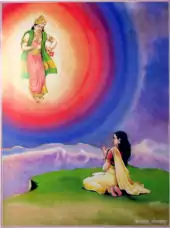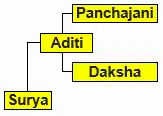Aditi
Aditi (Sanskrit: अदिति = "boundless”[lower-alpha 1] or "innocence",[3] is a Vedic goddess in Hinduism, the personification of the infinite. She is the goddess of the earth, sky, unconsciousness, the past, the future and fertility.[4] She is the mother of the celestial deities the Adityas, and is referred to as the mother of many gods. As celestial mother of every existing form and being, the synthesis of all things, she is associated with space (akasa) and with mystic speech (Vāc). She may be seen as a feminized form of Brahma and associated with the primal substance (mulaprakriti) in Vedanta. She is mentioned nearly 80 times in the Rigveda.
| Aditi | |
|---|---|
The Mother Goddess of the Devas; The Primordial Goddess of the Infinity, Unconsciousness, Sky and Fertility | |
 Aditi praying to the god Brahma | |
| Affiliation | Devi |
| Weapons | Sword, Trishula |
| Mount | Rooster |
| Texts | Rigveda, Puranas, Ramayana, Mahabharata |
| Personal information | |
| Parents | |
| Siblings | Diti, Kadru, Vinata, Sati, Swaha, Rohini, Revati, Danu, Muni and many other brothers and sisters |
| Consort | Kashyapa |
| Children | |
Family
Aditi is a daughter of Daksha and Asikni (Panchajani). The Puranas, such as the Shiva Purana and the Bhagavata Purana, suggest that Daksha married all of his daughters off to different people, including Aditi and 12 others to Kashyapa rishi. When Kashyapa was living with Aditi and Diti in his ashrama, he was really pleased with Aditi's services and told her to ask for a boon. Aditi prayed for one ideal son. Accordingly, Indra was born. Later, Aditi gave birth to others, namely Varuna, Parjanya, Mitra, Ansh, Pushan, Dhatri, Agni, Aryaman, Surya, Bhaga and Vamana.[5]
Origin
The first mention of Aditi is found in Rigveda, which is estimated to have been composed roughly during 1700-1100 BCE.[6] She is portrayed as the mother of the Adityas, a group of societal Rigvedic deities, including Varuna, Mitra, Aryaman, Daksha, Bhaga, Amsha, and sometimes Surya and Savitar. As the mother of the societal deities, she represented the compliance to social behavior. Her motherhood was also an important attribute, and later was expanded so that she became the mother of all deities.[3]
According to the Shatapatha Brahmana (a commentary on the Shukla Yajurveda), Aditi is also invoked during ritual sacrificial offerings as being synonymous with the Earth:
'On the navel of the earth I place thee!' And further, 'In the lap of Aditi (the boundless or inviolable earth)!' for when people guard anything very carefully, they commonly say that 'they, as it were, carried it in their lap;' and this is the reason why he says, 'In the lap of Aditi!'
Attributes
Motherhood

Aditi with sage Kashyapa had 33 sons, out of which twelve are called Âdityas including Surya, eleven are called Rudras and eight are called Vasus.[8] Aditi is said to be the mother of the great god Indra, the mother of kings (Mandala 2.27) and the mother of gods (Mandala 1.113.19). In the Vedas, Aditi is Devamata (mother of the celestial gods) as from and in her cosmic matrix all the heavenly bodies were born. She is preeminently the mother of 12 Âdityas, whose names include Vivasvān, Aryamā, Pūṣā, Tvaṣṭā, Savitar, Bhaga, Dhātā, Varuṇa, Mitra, and Śakra.
She is also the mother of the Vamana, avatar of Vishnu. [9] Accordingly, the Vamana avatar, as the son of Aditi was born in the month of Shravana (fifth month of the Hindu Calendar, also called Avani) under the star Shravana. Many auspicious signs appeared in the heavens, foretelling the good fortune of this child.
In the Rigveda, Aditi is one of the most important figures of all. As a mothering presence, Aditi is often asked to guard the one who petitions her (Mandala 1.106.7; Mandala 8.18.6) or to provide him or her with wealth, safety, and abundance (Mandala 10.100; 1.94.15).
Creativity

Aditi is usually mentioned in the Rigveda along with other gods and goddesses. There is no one hymn addressed exclusively to her, unlike other Vedic gods. She is perhaps not related to a particular natural phenomenon like other gods. Compared to Ushas and Prithvi, Aditi can be defined as the cosmic creator.
The verse "Daksha sprang from Aditi and Aditi from Daksha" is seen by Theosophists as a reference to "the eternal cyclic re-birth of the same divine Essence"[10] and divine wisdom.[11]
Freedom
The name Aditi includes the root "da" (to bind or fetter) and suggests another attribute of her character. As A-diti, she is an unbound, free soul and it is evident in the hymns to her that she is often called to free the petitioner from different hindrances, especially sin and sickness. (Mandala 2.27.14). In one hymn, she is asked to free a petitioner who has been tied up like a thief (Mandala 8.67.14). As one who unbinds, her role is similar to her son Varuna's as guardian of Rta, cosmic moral order. She is called the supporter of creatures (Mandala 1.136).
Might
Aditi was attributed the status of first deity by the Vedic culture, although she is not the only one attributed this status in the Vedas. She is addressed in the Rigveda as "mighty".
Others
Like many other Hindu gods and goddesses, Aditi has a savari (a mount). Aditi flies across the boundless sky on a phoenix. The phoenix symbolizes strength and honor. Her weapons include the famous Trishula and a sword.
Temple
A well known old temple of Aditi is located near rock cut cave in Vizhinjam, Kerala.
See also
Notes
- From a- (privative a) and diti "bound," which is from the Proto Indo-European root *da- "to bind."
References
- Stephanie Jamison (2015). The Rigveda –– Earliest Religious Poetry of India. Oxford University Press. p. 43. ISBN 978-0190633394.
- Mani 2015.
- Jamison, Stephanie; Brereton, Joel (2015). The Rigveda –– Earliest Religious Poetry of India. Oxford University Press. p. 43. ISBN 978-0190633394.
- Aditi at the Encyclopædia Britannica
- Gopal, Madan (1990). K.S. Gautam (ed.). India through the ages. Publication Division, Ministry of Information and Broadcasting, Government of India. p. 62.
- Oberlies (1998:155) gives an estimate of 1100 BC for the youngest hymns in book 10. Estimates for a terminus post quem of the earliest hymns are more uncertain. Oberlies (p. 158) based on 'cumulative evidence' sets a wide range of 1700–1100
- "Satapatha Brahmana Part 1 (SBE12): First Kânda: I, 1, 2. Second Brâhmana". www.sacred-texts.com. Retrieved 28 December 2019.
- Sathyamayananda, Swami. Ancient sages. Mylapore, Chennai: Sri Ramakrishna Math. p. 173. ISBN 81-7505-356-9.
- "Srimad Bhagavatam Canto 6 Chapter 6 Verses 38-39". Vedabase.net. Archived from the original on 20 March 2012. Retrieved 13 August 2012.
- The Secret Doctrine 2:247n
- "Adi-Ag: Encyclopedic Theosophical Glossary". Theosociety.org.
Further reading
- Mani, Vettam (1 January 2015). Puranic Encyclopedia: A Comprehensive Work with Special Reference to the Epic and Puranic Literature. Motilal Banarsidass. ISBN 978-81-208-0597-2.
- Kinsley, David. Hindu Goddesses: Vision of the Divine Feminine in the Hindu Religious Traditions, Motilal Banarsidass Publications, 1998. ISBN 978-81-208-0394-7
